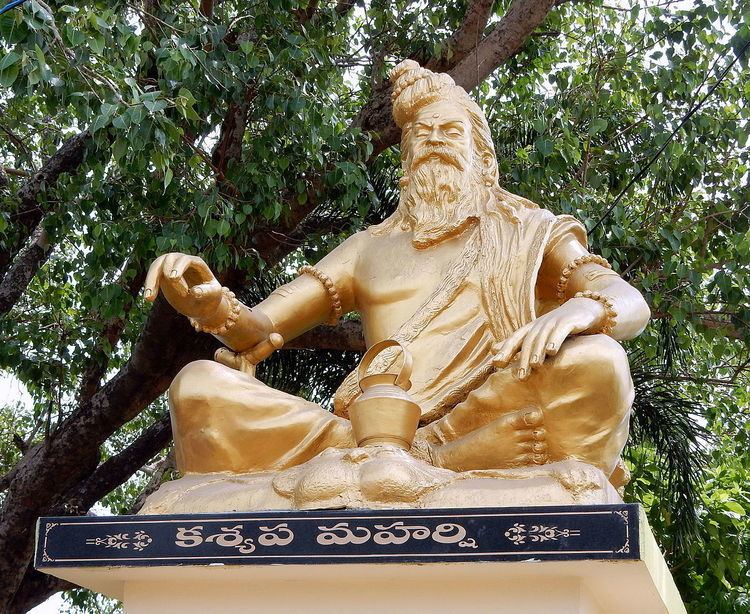Known for Rigvedic hymns | ||
 | ||
Kashyapa (IAST: Kaśyapa) is a revered Vedic sage of Hinduism. He was one of the seven ancient sages (rishi) considered as Saptarishis in Rigveda, numerous Sanskrit texts and Indian mythologies. He is the most ancient rishi listed in the colophon verse in the Brihadaranyaka Upanishad, and called a self-made scholar in the Atharvaveda. He was based in northwestern part of the Indian subcontinent, and legends attribute the region of Kashmir to be derived from his name.
Contents
Kashyapa is a common ancient name, referring to many different personalities in the ancient Hindu and Buddhist texts.
History
Kaśyapa, alternatively kasiiapa, means "turtle". According to Michael Witzel, it is related to Sogdian kyšph, New Persian kašaf, kaš(a)p which mean "tortoise", after which Kashaf Rūd or a river in Turkmenistan and Khorasan is named. According to Frits Staal, Kaśyapa means tortoise but it is a non-Indo-European word.
Kashyapa is one of Saptarishi, the seven famed rishis considered to be author of many hymns and verses of the Rigveda (1500-1200 BCE). He and his family of students are, for example, the author of the second verse of 10.137, and numerous hymns in the eighth and ninth mandala of the Rigveda. He is mentioned in verse 2.2.4 of the Brihadaranyaka Upanishad, along with Atri, Vashistha, Vishvamitra, Jamadagni, Bharadwaja and Gotama. Kashyapa is also mentioned as the earliest rishi in colophon verse 6.5.3 of Brihadaranyaka Upanishad, one of the oldest Upanishadic scriptures of Hinduism.
Kashyapa is mentioned in other Vedas and numerous other Vedic texts. For example, in one of several cosmology-related hymns of Atharvaveda (~1000 BCE), Kashyapa is mentioned in the allegory-filled Book XIX:
His name appears in Patanjali's ancient bhasya on verse 1.2.64 of Pāṇini. His name is very common in the Epic and Purana literature.
Buddhist texts
In Buddhist Pali canonical texts such as Digha Nikaya, Tevijja Sutta describes a discussion between the Buddha and Vedic scholars of his time. The Buddha names ten rishis, calls them "early sages" and makers of ancient verses that have been collected and chanted in his era, and among those ten rishi is Kassapa (the Pali spelling of Kashyapa in Sanskrit).
Kashmir
Kashmir, the northern Himalayan region of the Indian subcontinent got its name from Kashyapa Rishi. According to the ancient legends, he reclaimed that land from a vast lake, his school was based there, and the land was named after him. The name Kashmir, states Christopher Snedden, may be a shortened form of "Kashyapa Mir" or the "lake of the sage Kashyapa", or alternatively derived from "Kashyapa Meru" or the sacred mountains of Kashyapa.
In ancient texts of Greece, linked to the expedition of Alexander the Great, this land has been called "Kasperia", possibly a contraction of "Kasyapamira". The word "Kaspapyros" appears in Greek geographer Hekataois text, and as "Kaspatyros" in Herodotus who states that Skylax the Karyandian began in Kaspatyros to trace the path of Indus river from the mountains to where it drained in the sea. Kaspatyros may be same as Kaspa-pyrus or Kasyapa-pur (city of Kashyapa) in other texts.
Texts
Kashyapa is revered in the Hindu tradition, and numerous legends and texts composed in medieval era are reverentially attributed to him in various Hindu traditions. Some treatises named after him or attributed to him include:
Mythology
Kashyapa is mentioned in numerous mythologies of the Puranas and the Hindu Epics. These stories are widely inconsistent, and many are considered allegorical. For example, in the Ramayana he was married to eight daughters of mythical Daksha, while in the Mahabharata and Vishnu Purana he is described as married to thirteen daughters. Some of the names of the thirteen daughters Kashyapa married in the mythology of Vishnu Purana are different than the list found in Mahabharata. Some fables describe him as son of Marichi and a descendant of the solar dynasty, others as a descendant of Uttamapada who married the Daksha daughters, and yet others relate a Kashyapa as a descendant of the mythical Hiranya Kashyapa. These mythologies may correspond to different characters, all named Kashyapa.
In some Puranic stories, Kashyapa is said to have drained the Kashmir valley to make it inhabitable. Some interpret this legend to parallel the legend of Buddhist Manjushri draining Nepal and Tibet, wherein the "draining" is an allegory for teaching ideas and doctrines, removing stagnant waters of ignorance and extending learning and civilization into the valley.
Wives and children
The Puranas and the Epics of Indian tradition mention Kashyapa and his genealogy numerous times. These are inconsistent, with allegorical stories exalting him as the father of all gods, men, demons and empirical universe, in some conflated as the tortoise avatar of the Hindu god Vishnu. In the Vishnu Purana, Kashyapa marries thirteen daughters of Daksha: Aditi, Diti, Kadru, Danu, Arishta, Surasa, Surabhi, Vinata, Tamra, Krodhavasha, Ira, Vishva and Muni.
Kashyapa, in the Vishnu Purana and Vayu Purana, is attributed to be the father of the Devas, Asuras Yakhsas dravidas and all living creatures with various daughters of Daksha. He married Aditi, with whom he fathered Surya or alternatively Agni, the Adityas, and in two inconsistent versions Vamana, an avatar of Vishnu, is the child of Aditi and Kashyapa. In these fables, Kashyapa is the brother-in-law of Dharma and Adharma, both of whom are also described as married to other daughters of Daksha.
Kashyapa in Sikhism
In Brahm Avtar composition present in Dasam Granth, Second Scripture of Sikhs, Guru Gobind Singh mentioned Rishi Kashyapa, as second avtar of Brahma. According to him, Rishi Kashyapa had great knowledge of Vedas and interpreted it very thoughtfully to whole world which bring them internal relief. He married with four wives, Banita, Kadru, Diti and Aditi and have many children out of them some remain religious (Deities) and other became irreligious (Demons).
